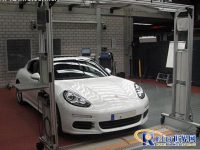
Porsche uses RFID technology to track prototype testing to ensure safety and quality
[ad_1]
German high-end car brand Porsche has adoptedRFIDSolutions to better manage new cars. Before the new model is launched on the market, the RFID system enables the tracking of vehicle components in the laboratory stage and the road running stage. The RFID system, provided by noFilis, helps automakers identify and secure the components installed in the test vehicle, while tracking where the engine is started and how it is being tested, as well as the movement and parking of the test vehicle. In addition, the company uses a sensor-based technology solution to track new cars in order to better manage prototypes.
“Porsche needs innovative software solutions to improve the production management process.” Thomas Grabscheit is an RFID and sensor specialist at an IT service provider called MHP under Porsche.

After the test was completed, the prototype car passed through the channel where Kathrein RFID readers and antennas were installed, and the car components were identified by RFID tags.
Porsche conducts a series of speed, performance or other functional tests on new cars fitted with special components. Some of these tests are carried out in the laboratory, and some are carried out on the road outside the factory.
Hundreds of automotive components are mainly tested, produced by Porsche or third-party suppliers. During testing, each component is performance tested to ensure optimal overall performance. Previously, the tracking of parts during the testing process required manual recording of information such as serial numbers, which were then entered into the system database. Sometimes, parts need to be disassembled to see information such as the serial number above.
Porsche approached noFilis for an intelligent solution to reduce possible errors in the recording process. The system, called the “Glöserner Prototyp”, consists of EPC UHF RFID tags mounted on 200 components, each with a unique ID code in memory and component details. Components with RFID tags are installed on the prototype vehicle. After the test is completed, all components are identified through the RFID read-write channel. The read and write channel consists of Kathrein RRU4-ELC-E6 reader, wide-range antenna and noFilis’ CrossTalk Agent, which is installed on the reader, and the system can still run when the local network is unavailable.
The ID of the tag can also be read with a Nordic ID handheld reader. Due to the wide variety of labelling components, such as airbags, air filters and catalytic converters, different RFID tags from Confidex and Smartrac were used accordingly.
The system is also used to track the prototype itself, and when the prototype leaves the factory, it needs to ensure that the movement of the vehicle is authorized and that it needs to know when it leaves. In this way, Porsche expects to reduce the likelihood that others will see the prototype. After installing the RFID solution, the filling out of the prototype vehicle’s exit pass and the permission of the gate guard to pass can be completed automatically. Every car has an RFID tag affixed to the windshield. When the car passes the gate, the Kathrein reader automatically reads the ID of the tag. The CrossTalk software installed on the Porsche server forwards the data to the company’s management system to determine whether it is authorized to pass. If authorized, CrossTalk records the time of departure. When the car returns, the plan makes the same time record and calculates the length of time the prototype car is outside.
In addition, Kathrein readers have been installed in the parking area of the factory. The locomotive needs to be well protected during the test. Porsche is already using RFID technology during the Bench test. The automaker installs RFID tags in the locomotive’s head tray, while readers are installed under 20 test stations. In addition, the company attaches RFID tags to the parts in the locomotive head. Catalytic converters are challenging to install with RIFD tags due to their high temperatures. To solve this problem, a metal protective sleeve is added to the label.
After a series of tests, the test results are stored in the company software. CrossTalk software associates a pallet tag’s ID with a number of different components, and when a test station reader reads the tag ID, it indicates that a test is in progress. Furthermore, the labeling tray allows the staff to know the specific location of the locomotive head, such as when it is placed in the warehouse.
The next step in the prototype vehicle management system is to enable sensor technology to correlate the prototype vehicle’s performance with the vehicle’s ID and location. The system will send the location data collected by GPS and the engine temperature, ignition or ventilation status, tire pressure, vehicle speed and other information collected by sensors to the CrossTalk software through GPRS network technology.
[ad_2]



